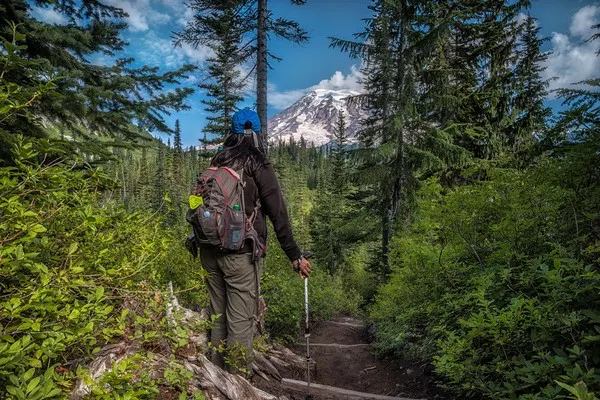Hiking alone can be a deeply rewarding experience, offering solitude, self-discovery, and a unique connection with nature. However, venturing into the wilderness solo also demands careful planning, preparation, and a keen awareness of safety considerations. Whether you are an experienced hiker or new to the trails, this comprehensive guide will provide you with essential tips and strategies for a successful solo hiking adventure.
Why Hike Alone?
The decision to hike alone is a personal one, often driven by a desire for solitude, independence, or the opportunity for introspection. Unlike group hikes, solo hiking allows you to set your own pace, choose your route freely, and fully immerse yourself in the natural environment without distractions. It can be a profound way to reconnect with yourself and the wilderness around you.
Assessing Your Skills and Fitness
Before embarking on a solo hiking trip, honestly assess your hiking skills and physical fitness. Choose trails that match your abilities and experience level. If you’re new to hiking, start with well-marked, popular trails that are within your comfort zone. As your skills improve, gradually challenge yourself with longer or more remote routes.
Regular physical fitness is crucial for solo hiking, as you may need to rely solely on yourself in case of emergencies. Build your strength and endurance through regular exercise and practice hiking with a weighted backpack to simulate trail conditions.
Planning Your Solo Hike
1. Research and Choose Your Trail Wisely
Selecting the right trail is paramount for a successful solo hike. Research potential trails thoroughly, considering factors such as distance, elevation gain, terrain difficulty, and current trail conditions. Websites, guidebooks, and local hiking forums can provide valuable insights and reviews from other hikers.
When choosing your trail, consider your comfort level with solitude and remoteness. Decide whether you prefer well-traveled paths or more secluded routes. Always inform someone of your hiking plans, including your intended route, expected return time, and emergency contacts.
2. Check Weather Conditions
Weather can significantly impact your hiking experience and safety. Check weather forecasts for your chosen hiking day and location. Be prepared for sudden changes in weather by packing appropriate clothing and gear, including rain gear, extra layers, and a reliable navigation system in case of low visibility.
Essential Gear and Equipment
Packing the right gear is essential for solo hiking. While your gear list may vary depending on the trail and season, here are some fundamental items to include:
- Navigation Tools: Carry a detailed map, compass, or GPS device, and know how to use them.
- First Aid Kit: Pack a well-stocked first aid kit tailored to hiking injuries.
- Emergency Shelter: Bring a lightweight emergency shelter, such as a tent or bivy sack.
- Food and Water: Carry ample food and water for the duration of your hike, plus extra supplies in case of unexpected delays.
- Clothing: Dress in moisture-wicking layers suitable for the weather conditions.
- Safety Items: Include a headlamp or flashlight, whistle, multi-tool, and fire-starting supplies.
Safety Precautions
Solo hiking comes with inherent risks, but you can mitigate them with careful planning and preparation:
- Leave No Trace: Practice responsible hiking by minimizing your impact on the environment and leaving no trace of your presence.
- Stay Hydrated and Nourished: Drink water regularly and snack on energy-rich foods to maintain your energy levels.
- Trust Your Instincts: If a situation feels unsafe or unfamiliar, trust your instincts and consider turning back.
- Be Aware of Wildlife: Research the local wildlife and know how to react in case of encounters.
- Emergency Protocols: Familiarize yourself with emergency procedures, such as signaling for help and basic wilderness first aid.
Mental Preparedness
Apart from physical fitness, solo hiking requires mental preparedness. Embrace the solitude and use it as an opportunity for self-reflection and mindfulness. Stay focused on your surroundings, maintain a positive mindset, and practice self-reliance while remaining alert to potential hazards.
Leave No Trace Ethics
As a solo hiker, it’s crucial to minimize your impact on the environment. Adhere to Leave No Trace principles by packing out all trash, staying on designated trails, respecting wildlife, and avoiding unnecessary noise. Preserve the natural beauty of the wilderness for future hikers to enjoy.
Conclusion
Solo hiking offers unparalleled opportunities for self-discovery and adventure but demands careful planning and respect for nature. By honing your skills, preparing diligently, and embracing the experience with an open mind, you can enjoy safe and fulfilling solo hikes in some of the world’s most breathtaking landscapes.
Remember, every solo hike is a journey of self-reliance, empowerment, and connection with nature. With the right mindset and preparation, you can embark on memorable solo hiking adventures that enrich your spirit and deepen your appreciation for the great outdoors.

